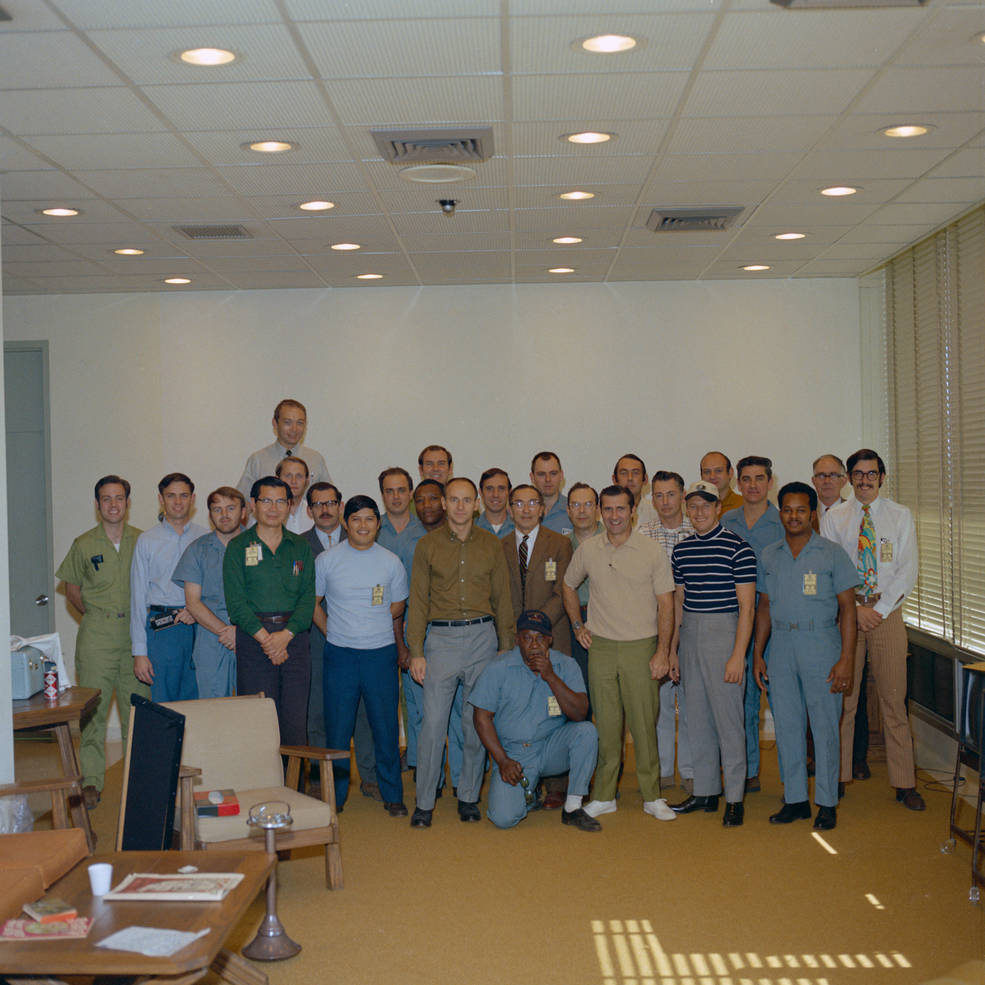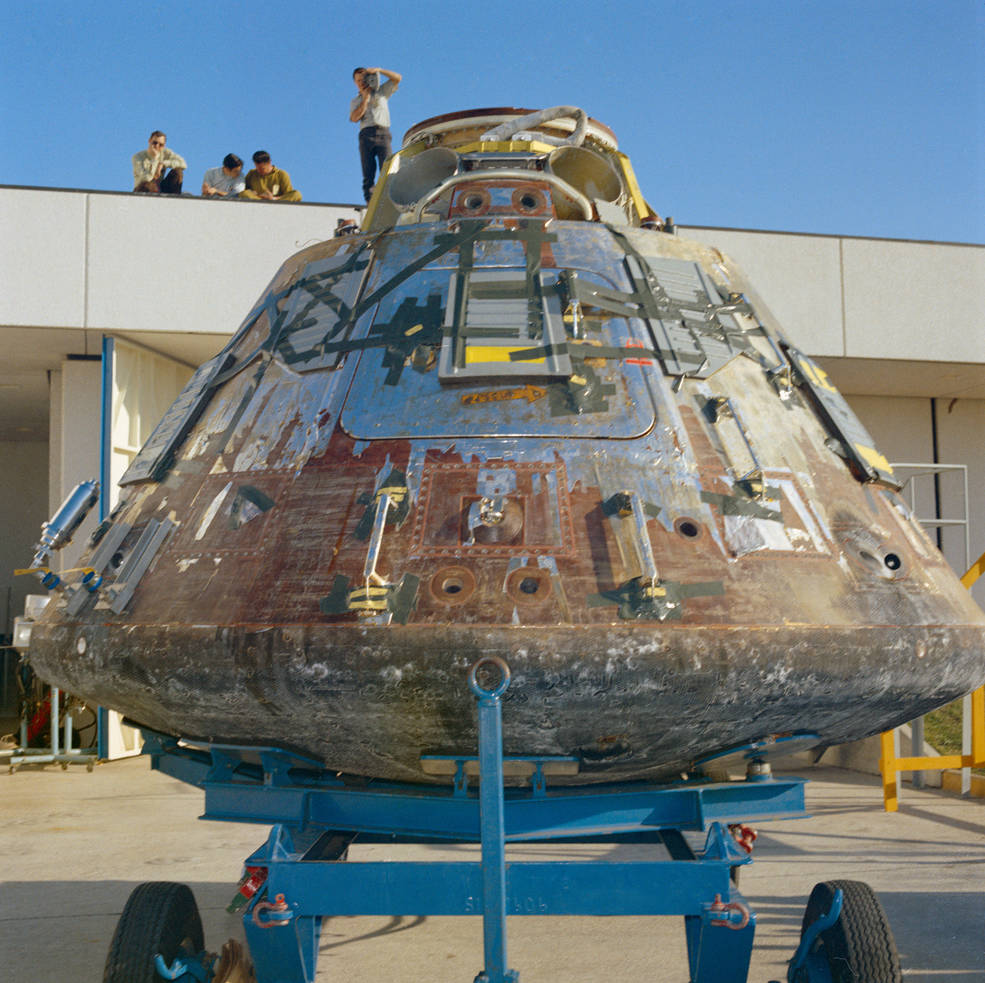Apollo 12 splashed down in the South Pacific 375 miles east of Pago Pago, American Samoa, on Nov. 24, 1969, successfully completing the second lunar landing mission. The Command Module (CM) Yankee Clipper and the crew of Charles “Pete” Conrad, Richard F. Gordon, and Alan L. Bean were successfully recovered and delivered aboard the Prime Recovery Ship (PRS) USS Hornet (CVS-12). To prevent back contamination of the Earth with any possible lunar organisms, once aboard the carrier the astronauts entered the Mobile Quarantine Facility (MQF) along with NASA flight surgeon Dr. Clarence A. Jernigan and NASA recovery engineer Brock R. “Randy” Stone. The recovery operations intended to return the astronauts inside the MQF, Yankee Clipper, and the lunar samples and film magazines to the Lunar Receiving Laboratory (LRL) at the Manned Spacecraft Center (MSC), now the Johnson Space Center in Houston, as expeditiously as possible while maintaining the strict biological isolation protocols.



Left: A C-2 Greyhound aircraft takes off from the deck of Hornet carrying the first box of Apollo 12’s lunar samples en route to Pago Pago. Middle: A C-141 Starlifter cargo plane lands at Ellington AFB in Houston carrying the first box of Apollo 12’s lunar samples. Right: Workers carry the first box of Apollo 12’s lunar samples from the C-141.
Within an hour after the astronauts arrived on board Hornet, the sailors lifted Yankee Clipper out of the water and towed it below to the hangar deck next to the MQF. Workers attached a hermetically sealed plastic tunnel between the MQF and Yankee Clipper, allowing Stone to leave the MQF and open the hatch to the capsule without breaking the biological isolation barrier. He retrieved the two Sample Return Containers (SRC) containing the lunar samples, the bags containing the Surveyor parts, film cassettes, and mission logs from the capsule and returned them to the MQF. Stone sealed the SRCs, film cassettes, and medical samples taken inside the MQF in plastic bags and transferred them to the outside through a transfer lock that included a decontamination wash. Outside the MQF, NASA engineers placed these items into transport containers and loaded them aboard two separate aircraft. The first aircraft, a C-2 Greyhound, carrying one SRC and a second package containing film departed Hornet within nine hours of the recovery, flying to Pago Pago 380 miles to the west. From there the two containers were placed aboard a C-141 Starlifter cargo aircraft and flown directly to Ellington Air Force Base (AFB) near MSC in Houston, arriving there late in the afternoon of Nov. 25. A second C-2 departed Hornet 14 hours after the first and included the second SRC, additional film as well as the astronaut medical samples. It flew to Pago Pago where workers transferred the containers to another cargo plane that flew them to Houston. Quarantine Control Officers in the LRL carried the containers from the transport aircraft to a NASA vehicle to make the 15-minute drive to the LRL to place them in quarantine.


Left: Engineers offload the first shipment of Apollo 12 lunar samples and film at the LRL’s loading dock at MSC. Right: Technicians log in the first shipment of Apollo 12 lunar samples and film at the LRL’s loading dock.
Technicians in the LRL unpacked the first SRC from its shipping container, weighed it, and installed it in a glovebox in the Vacuum Laboratory. Conrad and Bean had sealed the box in the vacuum of the lunar environment and the glovebox provided a vacuum to prevent Earth’s atmosphere from contaminating the pristine samples. Based on the Apollo 11 experience, scientists updated their procedures for examining the lunar samples and were more efficient in processing them. On Nov. 27, one of the samples was sent off to the radiation counting lab for gamma radiation sampling, with the examination of the rest of the samples beginning on Nov. 30.


Left: Technician weighs the first Apollo 12 SRC inside the LRL. Right: Technicians place the first Apollo 12 SRC inside a glovebox at the LRL.


Left: The first Apollo 12 SRC inside the glovebox at the LRL. Right: Scientists get the first glimpse of the Moon rocks after opening the first Apollo 12 SRC.
Meanwhile, in the Pacific Ocean, Hornet set sail for Pearl Harbor, Hawaii, as soon as Yankee Clipper was secured below decks, with the astronauts inside the MQF to maintain the strict back-contamination protocols. The day after splashdown, Hornet’s commanding officer Capt. Carl J. Seiberlich officiated at a formal welcoming ceremony for the Apollo astronauts that also included celebrating the 26th anniversary of Hornet’s commissioning in November 1943. During the voyage, the astronauts rested and began to organize their thoughts for the postflight debriefings that began once they arrived in Houston. They also celebrated Thanksgiving on Nov. 27. Dr. Jernigan conducted regular medical examinations of the astronauts, who showed no ill effects from their ten-day spaceflight or any signs of infection by any lunar microorganisms. The crewmembers availed themselves of one amenity aboard the MQF that was a novelty at the time – a microwave oven for meal preparation.


Left: Welcome reception for Apollo 12 crew aboard Hornet. Right: Apollo 12 crew (left to right) Gordon, Bean, and Conrad with Flight Surgeon Dr. Jernigan (far left) inside the MQF during Hornet’s cruise to Pearl Harbor.



Left: Crewmen man the rails as Hornet sails into Pearl Harbor. Middle: Hornet displaying the Three More Like Before banner on arrival in Pearl Harbor. Right: Workers at Pearl Harbor offload the MQF from Hornet with the Apollo 12 crew inside. Credits: US Navy
On Nov. 28, Hornet arrived at Pearl Harbor, four days after Yankee Clipper was safely hoisted aboard – the voyage at sea taking longer than the trip home from the Moon! Using a crane, workers lifted the MQF with the astronauts inside onto a flat-bed trailer. After a brief welcoming ceremony including traditional Hawaiian flower leis, ukulele music and hula dancers, workers drove the MQF to nearby Hickam AFB, where Air Force personnel loaded it onto a C-141 Starlifter. After an eight-hour flight, the C-141 arrived at Ellington on the morning of Nov. 29, where the MQF was offloaded in front of a waiting crowd of well-wishers including MSC Director Robert L. Gilruth and Apollo 11 astronaut Neil A. Armstrong. The astronauts’ wives and children were on hand to welcome them home to Houston. Although still inside the MQF, the astronauts could talk with their families via a telephone connection and see each other through the windows. Workers placed the MQF on a flat-bed truck and drove it to the LRL. Less than two hours after landing in Houston the astronauts arrived inside the Crew Reception Area (CRA) where they spent the next 11 days. During their time in quarantine, they completed many of the postflight debriefs and examined the lunar rocks as well as the parts of Surveyor 3 such as its camera that they returned from the Ocean of Storms.


Left: Workers offload the MQF with the Apollo 12 crew inside from the C-141 at Ellington AFB. Right: MSC Director Gilruth welcomes the Apollo 12 crew home at Ellington AFB.


Left: Apollo 12 astronauts’ wives (left to right) Barbara Gordon, Jane Conrad, and Sue Bean greet their husbands upon their arrival at Ellington AFB. Right: Apollo 11 astronaut Armstrong greets the Apollo 12 crew upon their arrival at Ellington AFB.



Left: Workers drive the Apollo 12 astronauts inside the MQF from Ellington AFB to MSC. Middle: The MQF passing through the gate at MSC. Right: The MQF docked to the LRL.



Left: Conrad inspecting the Surveyor 3 camera in the LRL. Middle: Conrad (left) and Gordon inspecting some of the Moon rocks in the LRL. Right: Apollo 12 crew pose with the LRL personnel in the CRA.


Left: Apollo 12 CM Yankee Clipper arriving at the LRL. Right: Gordon signing Yankee Clipper in the LRL.
Postscript: The USS Hornet earned its place in history not only for its distinguished service to the United States in wartime but for the successful recovery of the first two Moon landing crews and their spacecraft. After the Apollo 12 recovery operations, Hornet sailed for its home port of Long Beach, California, on Nov. 29, arriving four days later. For a brief time, NASA and the US Navy considered designating Hornet as the PRS for Apollo 13, then scheduled for launch in March 1970. But Hornet was scheduled for decommissioning in June 1970, and that would not leave enough time for all the required deactivation and preservation work. The slip of the Apollo 13 launch to April decided Hornet’s fate. After a few brief operations at sea, Hornet departed Long Beach for the final time, sailing to Bremerton, Washington, for deactivation, and the US Navy formally decommissioned her on June 26, 1970. In December 1991, Hornet earned a designation as a National Historic Landmark thanks to local community efforts in Washington. Hornet remained in Bremerton until 1994, when she was towed to the San Francisco Bay area to be scrapped, but in May 1995 was moved to Alameda Naval Air Station to serve as the venue for celebrations commemorating the 50th anniversary of the end of World War II. The Aircraft Carrier Hornet Foundation acquired the ship from the Navy and opened the USS Hornet Museum in October 1998, with Apollo 11 astronaut Buzz Aldrin speaking at the inauguration. The museum is moored at Alameda Point and visitors can see the MQF used during the Apollo 14 mission and the boilerplate Apollo capsule used during recovery training along with other space memorabilia.




























